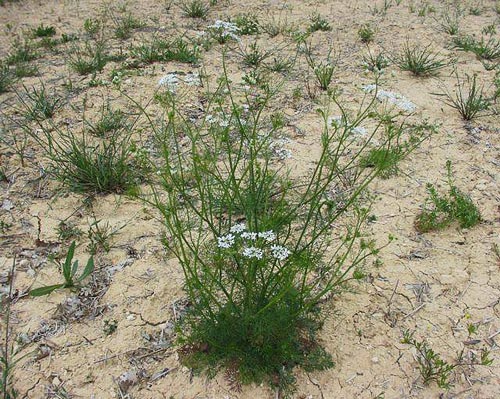Weeds
Bifora radians Bieb. - Wild bishop
Systematic position.
Family Apiaceae Lindl. (Umbelliferae Juss.), genus Bifora Hoffm.Biological group.
Spring annual.Morphology and biology.
Plant is 10-25 cm tall, rarely up to 60 cm, with thin spindle-shaped root. Stem is glabrous, grooved, slightly curved geniculately at knots. Leaves are also glabrous, pinnatisect twice or three times, upper leaves are sessile with small flat sheaths and filiform or hair-like lobes; lower leaves are petiolate, with linear, sharp, entire lobes. Petioles are cylindrical and fluted from above. Inflorescence is a compound umbel, which has 3-8 glabrous rays up to 2.5 cm long, the bract is absent or unifoliate. Secondary umbels consist of 7-9 flowers; outer flowers are bisexual, enlarged; inner ones are staminal, smaller; petals are white; bracteoles are unilateral, with 2-3 subulate-filiform leaflets. This plant flowers in June-August, bears fruits in August. Fruits are globular, didymous and sinuate at both the top and bottom, greenish-brown with dark brown stripes, verruculose, 3 mm long and 6 mm wide. Seeds are pale yellow, 2.5 mm long, 2 mm wide; they germinate from a depth of no more than 12 cm.Distribution.
The Caucasus, Crimea, Black Sea area. It is also distributed in the Mediterranean, Asia Minor, Iran and is an adventive plant in Middle Europe and North America.Ecology.
It is a thermophilic plant prefering nitrogen-containing, alkaline (solonetzic) soils.Economic significance.
This weed mainly infests spring crops. This species is a specific weed of coriander; fruits of these plants are practically non-separable, and the admixture of B. radians spoils the quality of essential oil produced from coriander. This plant is used as a spicy herb for many dishes and a savory salad is prepared from its leaves. Seeds contain 49% fatty oil. Control measures include thorough main and pre-sowing soil treatments.Reference citations:
Agaev M.G., ed. 1993. Useful weed plants in flora of the USSR. In: Catalogue of VIR world collection. N. 643. Leningrad: VIR. 160 p. (In Russian)Keller B.A., ed. 1934. Weed plants of the USSR. V. 3. Leningrad: AN SSSR. 448 p. (In Russian)
Lenkov P.V. 1932. Seeds of field weeds from European part of the USSR. Moscow-Leningrad: State Publishing House of Kolkhoz & Sovkhoz Literature. 320 p. (In Russian)
Nikitin, V.V. 1983. Weed plants of the USSR flora. Leningrad: Nauka. 454 p. (In Russian)
Shishkin, B.K., ed. 1950. Flora of the USSR. V. 16. Moscow-Leningrad: AN SSSR. 648 p. (In Russian)
Visyulina O.D., ed. 1970. Weeds of Ukraine (reference-identification guide). Kiev: Naukova Dumka. 508 p. (In Ukrainian)
Volkov A.N., ed. 1935. Areas of distribution of the major weed plants in the USSR. Moscow-Leningrad: Publishing House of Kolchoz & Sovchoz Literature. 153 p. (In Russian)
Wild bishop. 1999-2004. Weed database. Agricultural portal "Agro Mage": http://agromage.com/weeds_id.php?basa=1&la=ru&let=1968&id=bifra . (In Russian)
Wild bishop. 2003. Information database. Chemical control. Agrarian sector of Ukraine: http://agroua.net/plant/chemicaldefence/weeds/t-1/st-1/bg-1/bc-2/w-113/ (In Ukrainian)


